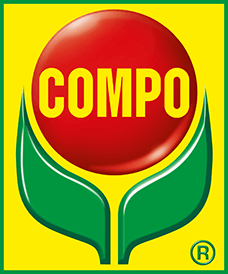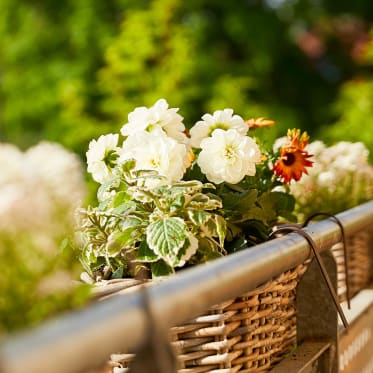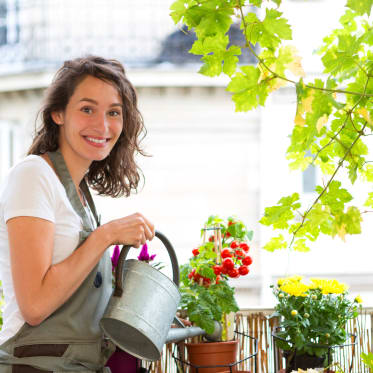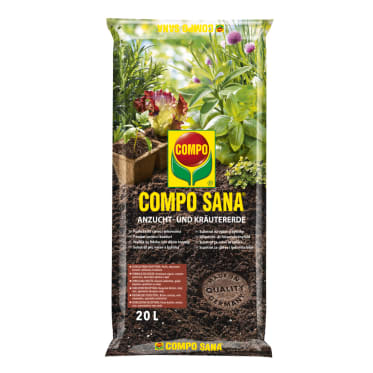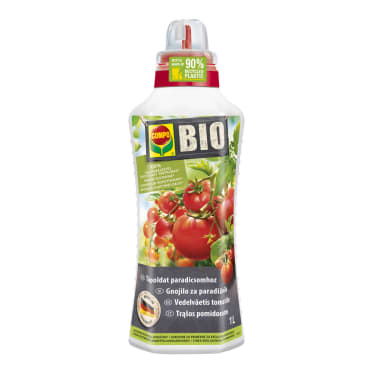Frequent search terms

- COMPO
- Guide
- Plant Care
- Herbs, fruits and vegetables
- Pre-germinating vegetables easily and without prior knowledge
A step-by-step guide to your own vegetable harvest
Pre-germinating vegetables easily and without prior knowledge
Are you dreaming of having your own vegetable garden or a snack corner on the balcony? To enable you to harvest many different types of vegetable in the summer, some plants have to be sown and pre-cultivated indoors. This step-by-step guide shows you how to sow seeds and pre-germinate your own vegetables successfully.
Table of content

When can you start to sow?
Most seeds need consistent, warm temperatures and moisture to germinate. But some of them like warmth a little more than others and differ in terms of their sowing date accordingly. For example, you need to wait until mid-May to sow climbing French beans, while you can plant broad beans as early as in March. Root vegetables such as carrots, small radishes or beetroot also grow very quickly and don't need high temperatures for germination. This means that they can be sown outdoors in March or April, depending on the weather.
Which vegetables should be pre-germinated?
Pre-germination on the windowsill or in a heated greenhouse is recommended for fruiting vegetables that love the heat, such as tomatoes, courgettes, watermelons, eggplants, pumpkins, cucumbers or chillis. These types of vegetable also take quite a long time to bear their first fruits. This means that sowing outdoors in the warmer months would take a very long time and you wouldn't get a bountiful harvest before the cold season sets in.
That's why it makes sense to sow heat-loving and slower vegetable types on a bright, warm windowsill and nurture them there until they can go outside in May. We call this pre-germination. But there are also different sowing dates among the vegetable plants that love heat, depending on species. For example, chillies need several months to produce the first ripe fruit. On the other hand, cucumbers and tomatoes grow much faster.
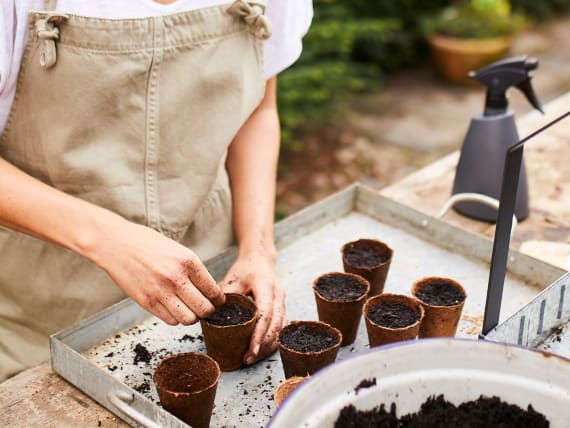
What do you need to pre-germinate vegetables?
You need neither a greenhouse nor prior experience to pre-germinate vegetables. All it takes is a pinch of enthusiasm, a few standard tools, a warm space and a few minutes of your time each day.
Of course, the amount of effort and space you need also depends on the number of vegetable plants you sow. For example, if you want to pre-germinate ten different varieties of tomato, three cucumbers and two courgettes, then a bright windowsill will suffice to begin with. But as time passes, the plants will grow and take up more space. Since late frosts can continue until the middle of May, you should plan sufficient space to accommodate the young plants until they are finally moved outdoors. A bright spot is ideal – and weather permitting, you can put the plants outside during the day and bring them in only at night.
It is advisable to use high-quality seeds that have good germination capacity and vitality. You should use a special propagating soil for the base, such as the COMPO SANA® Potting Soil for Herbs and Seedlings. Unlike typical potting soil, it contains few nutrients. This is essential because the seedlings will develop strong roots and are not overfed right at the beginning. In addition, propagating soil is sterilised, reducing the likelihood of fungal spores or other pathogens.
Also important for sowing:
- Containers (such as clean seed trays or seed pots)
- Spray bottle
- Small watering can
- Jar or plastic film (such as cling film)
- If necessary, plant markers for labelling the different varieties
As the vegetable plants gradually grow larger, you will also need plant pots and nutrient-rich vegetable soil.
How to pre-germinate vegetables!
1. Add the propagating soil and moisten it
Fill a seed tray or pot with special propagating soil and press down gently. Then make sure the soil is well moistened with water.

2. Sow the seeds
Now sow the seeds. To make it easier to separate the small seedlings later on, leave 1-2 cm of space between the seeds. If too many seeds end up together, you can use a toothpick to create more space.
3. Cover the seeds with soil
Sprinkle a thin layer of soil over the vegetable seeds. This will prevent them from drying out. Dark germinators like pumpkins or cucumbers need sufficient darkness to germinate. As a general rule, the soil should be no more than twice as thick as the size of the seeds. The soil layer should be a little finer for light germinators, such as tomatoes, as they need light for germination. You may find it helpful to spread the soil over the seeds with a sieve. Then moisten the seeds (or upper layer of soil) with the spray bottle.
If you're not sure whether the seeds are light germinators, dark germinators or light-neutral germinators, the rule of thumb is that the more delicate and small the seeds, the less soil you should spread over them.

4. Increase the humidity
You can put cling film over the seed tray to increase the humidity. This will also prevent the seeds from drying out. It's advisable to create several small holes in the cling film. You should also aerate the film daily and check whether the soil is still moist. Reach for the spray bottle if it's already a little dry.
Alternatively, you can put several seed trays or pots in a mini greenhouse. The same applies here, too: Air regularly.
5. Provide sufficient heat
In addition to moisture, the seeds also need plenty of heat to germinate. For example, chilli seeds germinate at temperatures of 20-30 °C. Place the plants on an electric blanket or heater, for example. The temperatures can be slightly lower again once the seeds have germinated – but now the light factor comes into play.
6. More air and light
Remove the cling film once the first green seedlings become visible. By now at the latest the seedlings should also be moved to a bright spot so that they have enough light for growth. If it's too dark, their stems will become thin and susceptible to disease.
You can prick out the vegetable seedlings after a few weeks. Discover how to do this in the next section.
Prick out the seedlings
The plants can be pricked out once they've grown a little. Pricking out means carefully transplanting the small plantlets into their own pot. In the case of chillies, tomatoes or eggplants, wait until the first real pair of leaves has formed before pricking out. The first 'real' pair of leaves refers to the first two leaves that form after the cotyledon or cotyledon pair. Read on for the best way to prick out:
- Fill pot with soil
Fill a pot with a mixture of propagating soil and nutrient-rich vegetable soil. The COMPO BIO Potting Soil for Tomatoes and vegetables is ideal for vegetables with a high nutrient uptake, such as tomatoes, peppers, courgettes or pumpkins. The pot should have drainage holes to allow excess water to run off and a diameter of 10-12 cm.
- Separate the seedlings
Carefully pry the seedlings out of the soil with a planting stick or pencil. Be careful not to cause too much damage to the roots. Minor injuries aren't a problem because they will actually encourage the seedling to grow new roots. But more serious injuries can result in the death of the plant.
- Plant and water the seedlings
Now create a small hole in the soil with your finger or the planting stick. Put the green plant into the hole up to the cotyledons. If necessary, add a handful of soil and then finish by carefully pressing everything down and watering the soil around the seedling so that it can take root more easily.

Pre-germinating vegetables – how to care for the young plants
Return the young plant to a bright spot with plenty of sunlight. Don't water the plant again until the top layers of soil have dried slightly. If you haven't used pre-fertilised plant soil, the vegetable plants will be looking forward to their first dose of liquid fertiliser after three to four weeks.
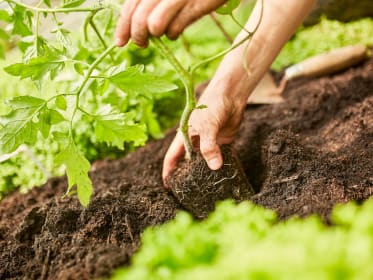
When can the vegetables go outside?
The vegetable plants can go outside for several hours at a time from April onwards when temperatures are mild during the day. A semi-shaded spot on the balcony or patio is perfect. This acclimatises the young plants to their new environment before they are planted outside. At the same time, you ensure your plants won't get sunburnt later on when they come into contact with the more intense heat of the summer sun in May. When the plants are well rooted in their pot and there's no longer a risk of late frosts, frost-susceptible fruit vegetables can be moved into the garden or onto the balcony permanently.
Is it possible to pre-germinate vegetables in a cold frame?
Some vegetables that are not sensitive to cold can be sown in a special cold frame without any problems at all. This is a type of mini greenhouse. Cold frames are available for vegetable patches or as a top for raised beds. They enable you to sow lettuce, small radishes or herbs, for example, a few weeks earlier than would normally be the case outdoors.
But if you want to pre-germinate vegetables that require warmer germination temperatures, then we recommend a heated greenhouse or bright and warm windowsill, as vegetables like tomatoes, chillies or eggplants will usually find a consistently warm environment there, which they need for the germination process.

How to sow in a vegetable patch
If you sow vegetables such as small radishes, lettuce or beans directly in a vegetable patch, it is especially important to pay attention to the spacing between plants. After all, these plants are not repotted but stay where they are. Since the spacing depend on the plant's size and root growth, you will usually find this information on the back of your seed bag. To better maintain spacing, create rows of 1-2 cm deep at the distance specified and then sow the seeds in those. You can also use seed strips, which make sowing directly easier for you.
Growing fruit and vegetables
More tips on growing vegetables
Suitable products for pre-germinating vegetables
